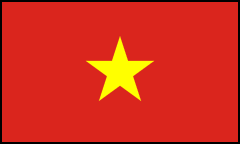Since January, the pandemic has messed up our daily routine namely the surging price of face masks and dry hand sanitizer, the high demand for stocking food, shops’ temporary closure, working from home. The pandemic has led to the economic crisis and its supply chain, not only in Vietnam but also across many countries.
Until now the Vietnamese government has controlled the invisible enemy pretty well but, we can not ignore negative impacts of the virus on our economy in general and industry sectors in specific. It is time for us to take action to fight against the pandemic as well as make the recovery. This article will focus on the Vietnamese retail supply chain and what they should do to combat the outbreak.
Vietnamese retain supply chain during the pandemic
According to a survey by CEL Vietnam, a consulting firm, 83% of companies in the physical value chain in Vietnam has suffered from supply issues over the past two months due to the impact of the COVID-19 pandemic. The major reason for this situation is that the main supplier of these companies is from China. The American Chamber of Commerce revealed that its members face difficulties in sourcing supplies and materials from Chinese suppliers.
Moreover, during the first three-week of April, the Vietnamese government issued national isolation, hence several automobile manufacturers namely Honda, Toyota, Nisan, and Ford that have production plants in Vietnam have to suspend their production. Merely essential businesses can operate during the national isolation to support the sufficient amount of food to residents.
The supply source becomes less abundant because many countries close their borders and limit the exchange of products. Myanmar canceled its commercial flights while European countries, US, and Canada implemented the restriction. Additionally, a lot of countries suspend the number of international flights which usually contain freight. Vietnam had canceled all international passenger flights since 1st April as well as limited the number of domestic flights during the national isolation. Consequently, the number of freights declined and the price of air freight augmented.
Furthermore, because of the less demand on unnecessary products, canceled orders result in the reduction of export and import products, then many companies have to let their workers stay at home or cut down human resources. Julien Brun, a managing partner at CEL, said that “Export-dependent companies are seeing orders canceled every day, particularly from the EU and the US. As a consequence, the global transport sector is also being affected and freight forwarder in Vietnam are seeing their volume drop by 25% to 70%.”
A shift to online shopping
During the pandemic, Vietnamese residents have changed their shopping habits from offline to online. Online shopping becomes trendy and food/ product delivery also becomes popular as well. Big C supermarket chain said that its stores in southern Vietnam reported 3000 online orders in March, up 1000 from the previous month. In Vietnam, certain categories witnessed a dramatic surge in demand such as package food (up 26%), dairy (up 10%), and personal care (29%).
What should the Vietnamese retail supply chain do during the pandemic?
1. Diversify the suppliers
The majority of Vietnamese businesses depend on Chinese suppliers. When China was the first country suffering from the pandemic, trading and goods exchange were restricted by the government. Many enterprises found it hard to seek another material source. For instance, last year, Vietnam imported almost $4 billion in car parts, because the raw material from China gets squeezed, we turn to import items from South Korea.
It would be better if we should not rely on only one source of supplier. Businesses should have different suppliers in different locations to ensure that the material supply will remain under circumstances such as in the event of the pandemic.
2. Take advantage of online distribution channels
During the pandemic, people are afraid of going outside, going to public places, hence residents tend to stay at home and order what they need via online delivery apps or via the companies’ websites. Despite the fear of the pandemic, there is a demand for buying goods or food, allowing businesses to operate.
3. Renegotiate the contract
It is vital for businesses to renegotiate the contract with suppliers, landlords, creditors, and employees. The pandemic has led to a huge loss in revenue of many enterprises working in a lot of sectors. The renting costs were still be paid even though the number of customers declined dramatically or the stores had to close temporarily.
To maintain the operation in the post-crisis situation, businesses need to maintain their location, their rent. However, the financial resource was narrowed down, it would be better if you can negotiate with the landlord to consider the rent costs. Furthermore, businesses renegotiate with suppliers to reduce the cost such as buying raw material on a limited scale or delaying shipment. Businesses can ask customers to pay in advance by giving them discounts.
According to the article “Five actions retail supply chains can take to navigate the coronavirus pandemic” from McKinsey, a working chain that retail suppliers should consider working well during the pandemic. The chain focuses on 5 factors: suppliers, merchandising, distribution, logistics, and fulfillment. Besides, two types of items including non-discretionary and discretionary categories are emphasized in the chain.
During the pandemic, the increasing demand for non-discretionary items has made some retailers be out-of-stock. It is essential for retailers to establish daily meetings with strategic suppliers to come up with appropriate options to respond with the high demand.
Another solution to speed up the rate of goods production is to reduce the variety of products and focus on the quantities. Furthermore, retailers can also reduce on-time, in-full requirements, as well as payment terms for key suppliers. In terms of discretionary categories, retailers work closely with suppliers to mitigate risk for existing orders.
Because of the high demand for non-discretionary items, retailers have to change their purchasing, planning, and inventory-management operation. Retailers revise buy plans and reallocate staff toward the most essential categories in the event of the pandemic as well as redirect inventory to high-density areas.
This step aids retailers in having enough coverage for key products. For discretionary categories, retailers should be flexible in near-term buy plans to preserve cash and adjust plans in case of a future increase in sales.
In the distribution step, to cope with the increasing demand, retailers can redeploy employees to distribution centers in high-demand areas. Additionally, salaries of staff working during the period should be raised or given incentives.
If raising wages is difficult for retailers this time, offering benefits or gifts can help you retain your staff. The most important thing is that retailers ensure good hygiene at the workplace.
In terms of logistics, as some products are sold out rapidly, retailers had better allocate more transport capacity to these high-demand products. Moreover, alternative options for delivery can be considered to distribute a sufficient amount of goods.
Fulfillment can be understood as reliable delivery. Retailers comply with some practices in delivery to meet the surge in demand. Retailers widen the delivery window, from immediate or same-day to two or three days. This practice allows retailers to reschedule the delivery time as well as optimize the route of deliveries (such as products delivered in one area will be grouped together).
Besides the retail supply chain, you can also gain information about how the Vietnamese healthcare industry does during the pandemic.
All in all, the retail supply chain needs to be adapted to meet the surge in demand for some product categories. Since the pandemic, Vietnamese companies find it difficult to seek raw materials because the majority of enterprises rely on Chinese suppliers. Therefore, to avoid the risk of material scarcity, and adapt to the situation, Vietnamese businesses should diversify suppliers, focus on online distribution channels and renegotiate contracts. Hope that your businesses will find some points interesting and helpful to your operation.








